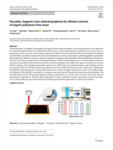

PARTNER
검증된 파트너 제휴사 자료
Reusable, magnetic laser‑induced graphene for efficient removal of organic pollutants from water
방대한 850만건의 자료 중 주제별로 만들수 있는 최적의 산출물을 해피 캠퍼스에서 체험 하세요 전문가의 지식과 인사이트를 활용하여 쉽고 폭넓게 이해하고 적용할수 있는 기회를 놓치지 마세요
18 페이지
최초등록일 2023.05.08
최종저작일
2022.06

-
 * 본 문서는 배포용으로 복사 및 편집이 불가합니다.
* 본 문서는 배포용으로 복사 및 편집이 불가합니다.
미리보기
서지정보
· 발행기관 : 한국탄소학회
· 수록지 정보 : Carbon letters / 32권 / 4호
· 저자명 : Ye Jiang, Sijie Wan, Weiwei Zhao, Wenjie Yu, Shuaipeng Wang, Zeqi Yu, Qiu Yang, Weihua Zhou, Xiaoqing Liu
목차
Abstract
Graphical abstract
1 Introduction
2 Experimental section
2.1 Materials
2.2 Preparation of Fe3O4@LIG
2.3 Characterization of Fe3O4@LIG
2.4 Methylene blue (MB) adsorption
2.5 Organic solvents adsorption
3 Results and discussion
3.1 Characterization of Fe3O4@LIG
3.2 Methylene blue adsorption on Fe3O4@LIG
3.3 Organic solvent adsorption on Fe3O4@LIG
3.4 Adsorption performance and mechanism
4 Conclusion
Acknowledgements
References영어초록
The hybridization of graphene with magnetic nanoparticles has endowed graphene with increasing interest as the adsorbent for wastewater treatment. However, its fabrication often involves a multi-stepped chemical synthesis process. In this work, we demonstrate a facile, one-step, and solvent-free approach to fabricate Fe3O4 nanoparticle-anchored Laser-Induced Graphene ( Fe3O4@LIG) as an efficient adsorbent by direct laser irradiation on a ferric acetylacetonate containing polybenzoxazine film. Raman and X-ray diffraction analysis confirm the graphene component in the adsorbent, and the morphology characterizations show that Fe3O4 nanoparticles are distributed uniformly on LIG with hierarchical meso- and macro-porous structures. Adsorption experiments indicate that Fe3O4@ LIG can adsorb methylene blue (MB) from aqueous solutions in a fast and effective manner, with a maximum adsorption capacity up to 350.9 mg/g. The adsorption kinetics and isotherms are also investigated, which are well-described by the pseudo-second-order model and Langmuir model, respectively. Additionally, Fe3O4@ LIG is also demonstrated with the efficient removal of a variety of organic solvents from water. The favorable adsorption behavior of Fe3O4@ LIG is attributed to its unique porous structure and the molecular interactions with adsorbates. On the other hand, Fe3O4@ LIG has high magnetic property, and therefore, it could be easily recovered from water and well regenerated for repeated use. With the efficient adsorption of organic pollutants, magnetic separability, and good참고자료
· 없음태그
-
자료후기
-
자주묻는질문의 답변을 확인해 주세요

꼭 알아주세요
-
본 학술논문은 (주)코리아스칼라와 각 학회간에 저작권계약이 체결된 것으로 AgentSoft가 제공 하고 있습니다.
본 저작물을 불법적으로 이용시는 법적인 제재가 가해질 수 있습니다. -
해피캠퍼스는 구매자와 판매자 모두가 만족하는 서비스가 되도록 노력하고 있으며, 아래의 4가지 자료환불 조건을 꼭 확인해주시기 바랍니다.
파일오류 중복자료 저작권 없음 설명과 실제 내용 불일치 파일의 다운로드가 제대로 되지 않거나 파일형식에 맞는 프로그램으로 정상 작동하지 않는 경우 다른 자료와 70% 이상 내용이 일치하는 경우 (중복임을 확인할 수 있는 근거 필요함) 인터넷의 다른 사이트, 연구기관, 학교, 서적 등의 자료를 도용한 경우 자료의 설명과 실제 자료의 내용이 일치하지 않는 경우
“Carbon letters”의 다른 논문도 확인해 보세요!
-
Realization of diamond nucleation within the multi‑walled carbon nanot.. 12 페이지
-
Fibrous and granular activated carbon mixed media for effective gas re.. 8 페이지
-
The relationship between the molecular composition of coal and the con.. 9 페이지
-
Assessment of carbon fibers recovered from lab‑scale versus pilot‑scal.. 15 페이지
-
In situ synthesis NiO/F‑MWCNTs nanocomposite for adsorption of malachi.. 12 페이지
문서 초안을 생성해주는 EasyAI
